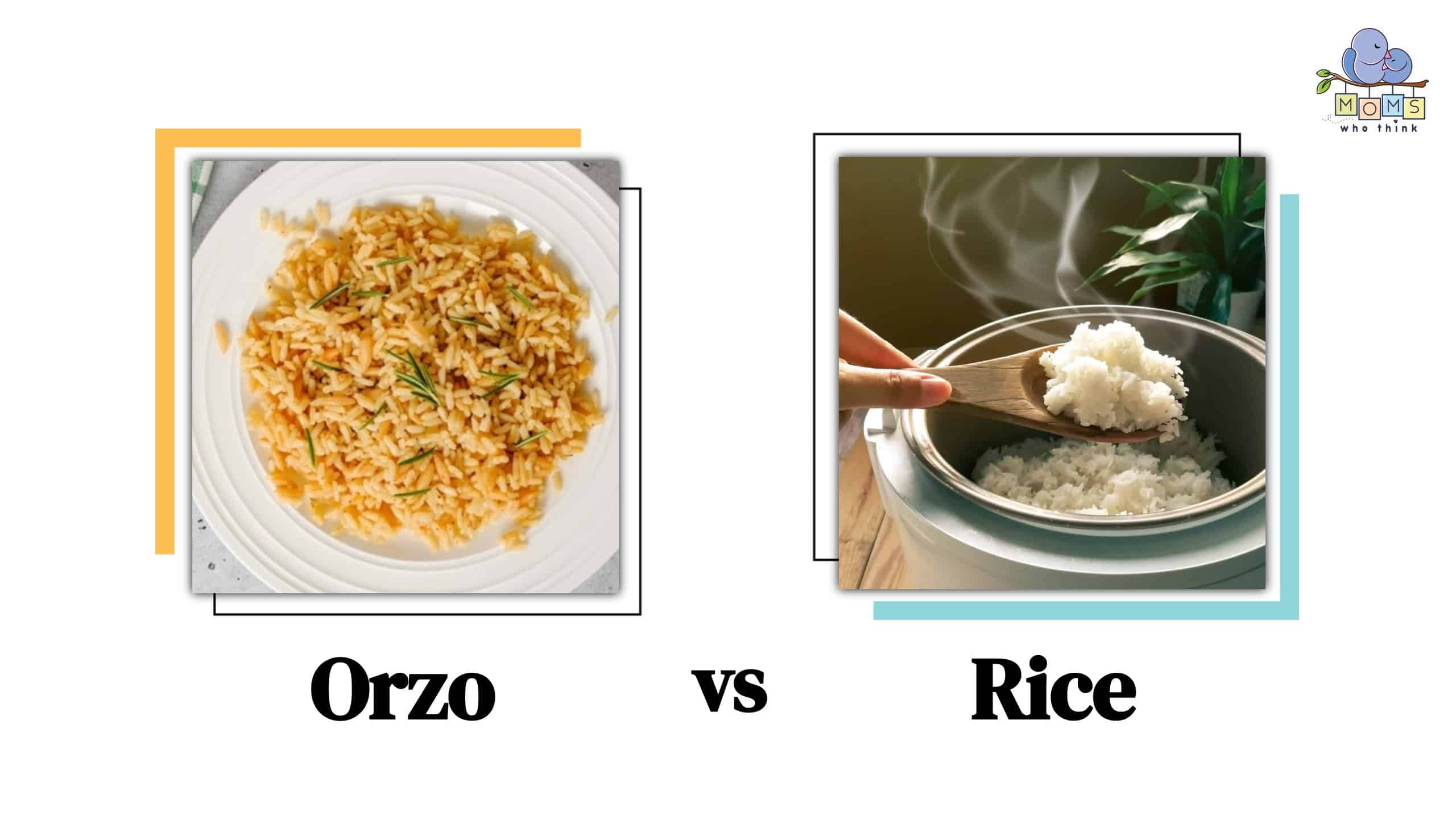If you’ve ever seen boxes of orzo in the grocery store or found a recipe for soup made with orzo, you might have wondered if this rice-shaped pasta tastes anything like rice. Although there are some similarities because orzo and rice, they have more differences than most people realize.
Unlike rice, orzo is an oval-shaped pasta that’s made from semolina wheat flour. Orzo is also typically creamier and softer than rice, although it can sometimes be substituted in a recipe that calls for rice.
Let’s take a look at some of the key differences between orzo and rice as well as the difference in their nutritional values. Keep reading to find out how they compare and whether you can substitute rice for orzo in your next recipe.
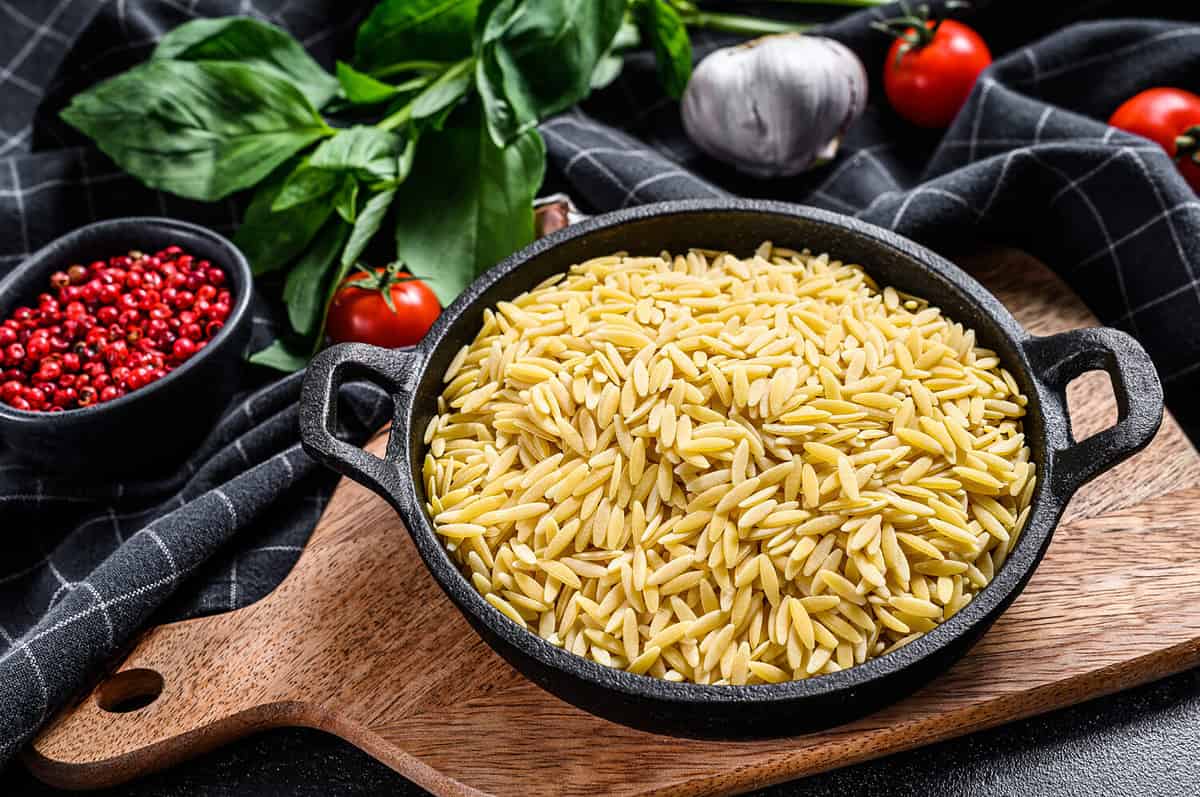
Orzo is a rice-shaped pasta that can be added to soups or used in pasta salad.
©Mironov Vladimir/Shutterstock.com
Orzo vs. Rice: What Is the Difference?
If you’ve ever started cooking a dish that called for rice but realized you didn’t have any, you may have looked for an acceptable substitute. Many wonder if orzo and rice are interchangeable. Despite their similar appearance, orzo and rice are actually very different. This is especially important to know if you have food allergies or are cooking for someone who does.
- The must-have convenient reference guide for every home cook!
- Includes more than 8,000 substitutions for ingredients, cookware, and techniques.
- Save time and money on by avoiding trips to grab that "missing" ingredient you don't really need.
While rice is a grain that comes from a specific plant, orzo is a rice-shaped pasta made from semolina wheat. In its natural form, rice is gluten-free and an acceptable side or base for someone who has gluten sensitivity or celiac disease. Orzo, on the other hand, is not gluten-free.
Although their shapes are similar, orzo and rice taste different as well. The texture and flavor of rice depend on how you cook and season it, but the consistency can range from sticky to mushy. Orzo has a much creamier and softer texture than rice and you can add sauce to it or add it to a soup recipe to prevent it from sticking together.
What is Orzo?
Even though orzo does look similar to rice, remember that they are different foods. Orzo is a rice or oval-shaped pasta made from semolina wheat like many other pasta shapes. This type of pasta is considered petite pasta, also known as a pastina, which translates to “small pasta.”
Typically, orzo is not whole grain, but you can purchase a whole wheat version of orzo. Orzo is a great base or addition to various soups, such as lemon chicken orzo. You can also toss it with pasta sauce or use it in pasta salad.
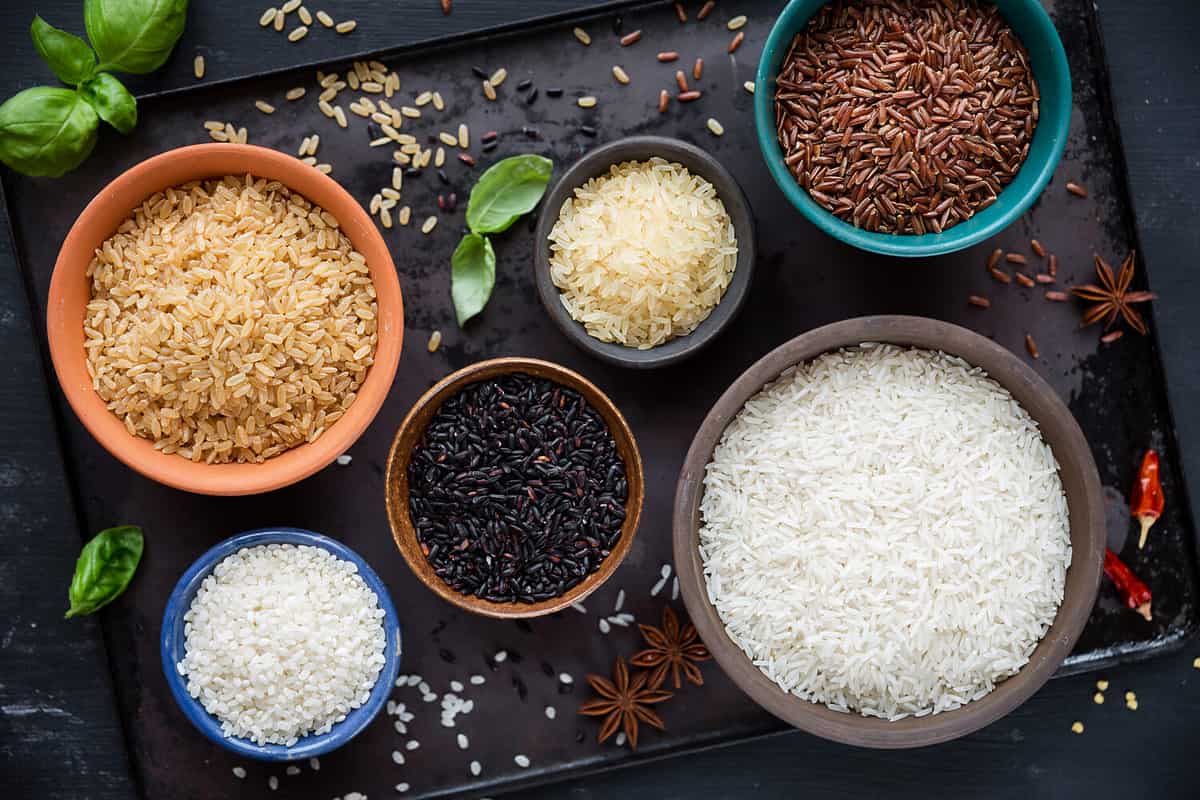
Rice comes in thousands of different types, but long-grain white rice is the most popular.
©kuvona/Shutterstock.com
What is Rice?
Unlike orzo, rice isn’t pasta. Instead, rice is a grain that comes from the Oryza Sativa plant. Although there are many different types of rice such as brown rice or wild rice, the most common type of rice used across the globe is long-grain white rice.
Long-grain white rice is used most commonly in American dishes and it’s also the most common type of rice used in Asian countries where rice is a staple.
Rice can come in many varieties such as long, short, or medium grain. Brown rice is another popular type of rice and has higher amounts of nutrients like antioxidants and fiber than white rice does. Brown rice is a whole grain and is essentially white rice without the outer layers of bran and germ removed. These outer layers provide brown rice with more nutrients and a different flavor than white rice.
Can Orzo Be Substituted for Rice?
Whether you find yourself in a pinch and only have orzo or rice for your recipe, or you’re simply wondering how switching out orzo for rice will affect your dish, you’re not alone. Due to their similar appearance, many people wonder whether orzo can be substituted for rice.
Although you can use orzo as a substitute for rice, they can’t necessarily be used interchangeably. If you choose to substitute one for the other, you will likely have to alter some parts of the recipe such as the amount of liquid and the cooking time. The texture is also going to be different even though they both come from grains.
It’s easy to mix up rice and orzo in the kitchen since they look so similar. You can use rice instead of orzo in your recipe, or vice versa, but if you do, be sure to adjust the cooking time and ingredients if necessary.
Nutritional Values for Orzo vs Rice
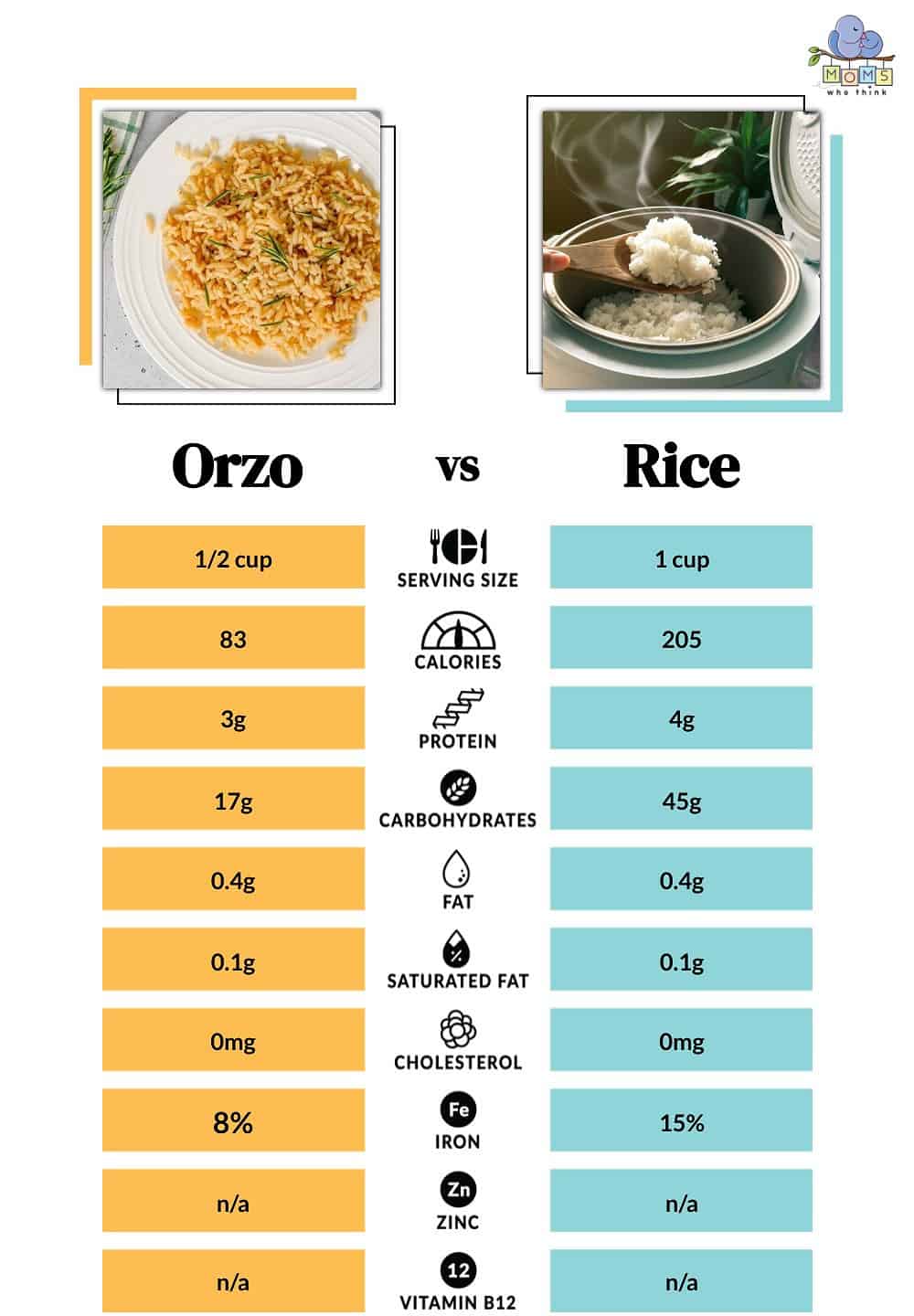
©
How Do You Cook Orzo?
Like most pasta, orzo is pretty simple to cook no matter what type of meal you’re making. The simplest way to cook orzo is to boil it in a pot of salted water for about 7-10 minutes. How long you cook the pasta is going to depend on how firm you prefer it to be and how much orzo you’re using.
Generally, you’ll use at least a half cup of water for every cup of orzo and the water should completely cover the orzo in the pot. You can also salt the water ahead of time for added flavor. In traditional Italian recipes, orzo is cooked al dente, which means it’s firm enough that it holds together but still soft enough to eat. It’s important not to overcook the pasta, especially if you’re not finished heating it. If you add it to a pot of simmering pasta sauce, for example, this may lead to overcooked orzo.
How Do You Cook Rice?
Cooking rice properly isn’t always as straightforward as cooking pasta like orzo. In fact, it can be a bit tricky to get the texture of rice just right. How much water you need will depend on the amount of rice, your method of cooking, and sometimes even the type of stove you’re using.
- The must-have convenient reference guide for every home cook!
- Includes more than 8,000 substitutions for ingredients, cookware, and techniques.
- Save time and money on by avoiding trips to grab that "missing" ingredient you don't really need.
Here’s an expert tip: always make sure you rinse your rice before cooking it. There is residual starch on the outside of the grains and rinsing the rice in water removes the extra starch. Although it won’t hurt you to cook rice without rinsing it, it prevents the rice from becoming too sticky.
The ratio of water to rice is the most important part of cooking perfect rice every time. Even though it may change based on the type of rice you’re making, the ratio is usually 1 cup of water to 2 cups of rice. You can cut this ratio in half or double it if you’re making more or less than 1 cup.
Once you have your ratio of water, bring it to a boil, and then add your rice and salt, allowing it to come back to a boil before reducing the heat to low. Cover your pot and simmer it for 15-18 minutes. You can also easily cook rice in an Instant Pot or rice cooker.
Deciding Between Orzo vs. Rice for Your Next Recipe
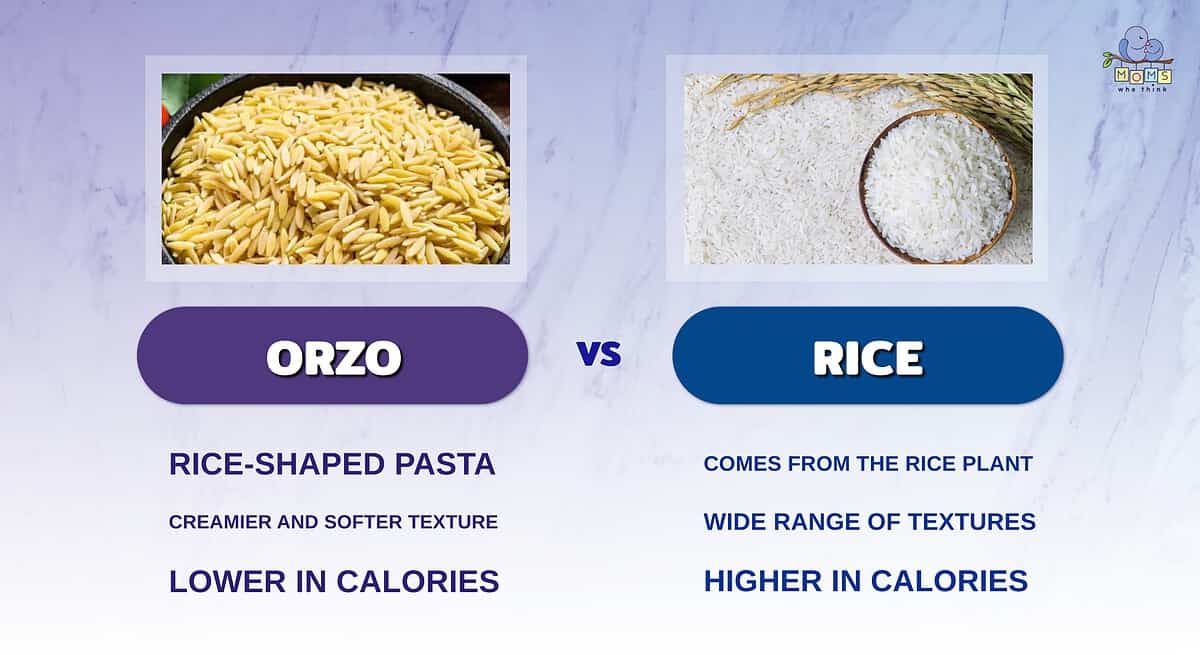
- Orzo has a creamier and softer texture than rice. Rice can have a variety of textures, from fluffy to sticky.
- Orzo is lower in calories compared to rice.
- Rice is a grain that comes from the rice plant, while orzo is actually a rice-shaped pasta.
Rice and orzo are both delicious additions to any meal as a side dish or base. Deciding which one works best for your recipe will depend on your preferences and what you have available in your cabinet.
Since orzo is a rice-shaped pasta, it does have a softer and creamier texture than rice. However, the flavor can be adjusted by changing your ingredients or seasoning. With a few adjustments to the amount of liquid in your recipe and the cooking time, you can substitute orzo for rice or vice versa. Keep this in mind next time you make pasta salad, a side dish, or a soup with either ingredient!
Orzo Recipes
PrintBroccoli Shrimp with Orzo
- Yield: 4 servings
Ingredients
2½ cups reduced sodium chicken broth
5 cups fresh broccoli florets
1 can (14½ ounces) diced tomatoes, undrained
1 cup uncooked orzo
1 pound uncooked medium shrimp, peeled and deveined
1 Tablespoon dried basil
1 teaspoon oregano
1 teaspoon salt
½ teaspoon pepper
2 Tablespoons butter
Instructions
1. Bring broth to a boil in a large pan.
2. Add the broccoli, tomatoes and orzo.
3. Reduce heat and simmer, uncovered, for 5 minutes, stirring occasionally.
4. Add the shrimp, basil, oregano, salt and pepper.
5. Cover and cook for 5 minutes longer or until shrimp turn pink and orzo is tender.
6. Stir in butter and serve.
Nutrition
- Serving Size: 1¾ cups
- Calories: 401
- Sodium: 919mg
- Fat: 10g
- Saturated Fat: 5g
- Carbohydrates: 45g
- Fiber: 4g
- Protein: 35g
- Cholesterol: 190mg
Rice Recipes
- Rice Side Dishes for Salmon
- 20 Easy Rice Side Dishes for Fish
- Quick and Easy Chicken Fried Rice
- Tex-Mex Fried Rice
- Savory Rice and Veggie Casserole
